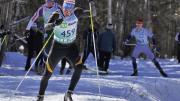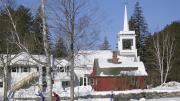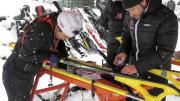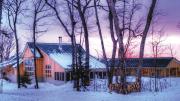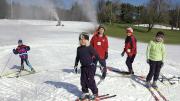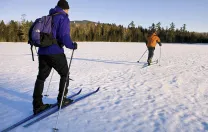Growing up west of Boston, Chris City ’94 began Nordic skiing as a child, first criss-crossing his own backyard, later gliding through the town forest, along ungroomed trails, to a nearby lake. That freedom of movement and the quiet access to the beauty of New England’s winter landscapes are part of what draws City to the sport: “You can stand on a trail and hear nothing but some birds and be completely away from the world.”
City still loves to ski by himself in the woods, but he also raced competitively in high school and became captain of the Harvard Nordic Ski Team—for which he is now head coach. Racing adds increased rigors of cardiovascular and technical training to recreational skiing. “It demands immense strength—legs, upper body, core—your whole body is working when you are playing this sport, so that it rewards people who like to be outside and active,” he says. There are always technical adjustments, too, he adds: in waxing and equipment, in coordinating mind and body to push on the uphill, then regroup and strategize going down, “so your brain is also constantly working.”
New England’s terrain offers a wide range of places to ski at all levels, for fun, competition, or both. For multiday trips, Maine Huts & Trails, two hours due north of Portland, offers about 50 miles of groomed trails and four “huts” (more like lodges) with amenities such as meals and hot showers. Also in Maine, the Appalachian Mountain Club oversees more than 80 miles of trails between and around two lodges near Moosehead Lake. Serious cross-country skiers, as well as newcomers to the sport and families, are also drawn to Vermont’s Craftsbury Outdoor Center in the Northeast Kingdom. Long-range trekkers may choose the Catamount trail (begun in 1984 and completed in 2008), which snakes through Vermont along 300 miles, from the Massachusetts to the Canadian border, while those who want a larger-scale European-style resort that still takes its trails seriously should head to The Trapp Family Lodge, on 2,500 acres in Stowe.
City also recommends the integrated series of trails that run in and around the village of Jackson, New Hampshire (just north of Conway), in the White Mountains. Operated by the Jackson Ski Touring Foundation, this system is akin to those in Europe in that it enables skiers to stay at homey inns in town, but easily access connected, longer trails that take them into the wilder landscape—or even to lodgings at a nearby village, the so-called “inn-to-inn” experience. The Ellis River Trail, for example, heads toward Pinkham Notch, with views of Mount Washington, and offers warm places to eat and sleep well at the end of the day.
A day trip from Boston, and especially good for beginners, is the family-owned Windblown, in New Ipswich, New Hampshire. Even closer is the suburban Weston Ski Track, only a 15-minute drive from Cambridge. Sited on a golf course, Weston has about 10 miles of trails with a mix of natural and man-made snow and terrain that accommodates new and advanced skiers, plus weekly races and lessons. “It’s lit at night,” City reports, “so it makes skiing possible as part of your weekday life: you don’t have to go on vacation to do it.”
The proximity of Weston and the increasing use of man-made snow there and elsewhere have contributed to the “slow and steady” rise in popularity of cross-country/Nordic skiing in New England during the last decade, according to Robert Bradlee ’79. A self-described “fanatical skier,” Bradlee skied in high school, at Harvard, and ever since, competing in the U.S. Senior Nationals and earning medals in the National Masters competition. “As global warming starts to trash our winters, or make them inconsistent, the trend is these man-made snow-making systems and small loop races for cross-country,” he reports. “Colby and Middlebury Colleges’ trails now have them, Craftsbury has them. We were able to hold major races the week after we had 80-degree weather in March of 2012.”
Bradlee is also a top teacher: the U.S. Ski and Snowboard Association named him “best domestic coach” last year. He trains some of the region’s best junior racers (under age 20) through the Cambridge Sports Union, a private club based at the Weston Ski Track. The best of those kids tend to rise up through the Eastern Massachusetts Bill Koch Youth Ski Club (for ages 8 to 13), a program that Bradlee says was built up, from 20 to 200 kids, by another avid Harvard skier, Burbank professor of political economy James Stock (father of Harvard Nordic ski captain Chris Stock ’14 and Dartmouth Nordic skier Corey Stock, who competed in World Cup races last year).
Anyone can probably get on a pair of Nordic skis and shuffle along for fun and exercise—and many do, every winter. But to get to the point where, as some skiers describe it, one is flying or floating above the snow, to master the sport, is not easy. “It’s like a chess game: complicated and hard to get right. It’s a failure-rich environment—and is therefore great for educating teenagers,” Bradlee reports of both those who want to compete and those who just love skiing for fun. “They don’t get enough chances to fail: they have to get straight A’s and be perfect. In skiing, you fall and screw up, and you have to learn that there’s always another race next time and you get up and try again. It’s about sticking with it and not quitting and, probably, in the long term, you will have good results.”
Cross-country skiing still requires the combined coordination of kicking and gliding, a weight-shifting, pendulum-like motion, proper timing, and coordination of limbs, to move the body smoothly across snow and ice. To do it well using the classic technique, a person kicks hard, but then slides to make progress, leaning forward from the ankles, with the body weight alternatively placed over each leg/foot.
The newer “skating” technique, pioneered by Olympian Bill Koch in the 1970s and commonly accepted by 1982, enables skiers to go about 30 percent faster by using less a striding motion than a lateral transfer of weight from one leg to the other by pushing off the ground, as in roller- or ice skating. “It involves more core strength and, like in swimming, more upper arms and back, because you are also using the poles for a big part of your power,” Bradlee notes. “That’s a big change in the sport. Racers [and now even many enthusiastic recreational skiers] now roller-ski to train all summer because it conditions the arms.” The skating technique is not necessarily equated with racing, and has actually helped more recreational skiers access the sport because many find it easier than the classic style, younger fans want the increased speed it fosters, and there is no need to apply kick wax.
Nevertheless, the classic technique is still widely practiced. Harvard Corporation member Paul Finnegan ’75, M.B.A. ’82, who was a “most valuable player” and captain of the Harvard Nordic ski team for two years, is now based in Chicago. He still skis—often on the five-mile and three-mile trails he set up on land he owns in Michigan—but he has never learned the skating technique. Ski racing “has been critical for me in terms of my own development, both physically and mentally,” he says. “In racing, your goal is to pass people on the uphill, seeking to disrupt their motion and technique. So you should be surging on the uphill, which is an enormous physical challenge, and there is mental pressure to push,” he reports.“In life you’ll have your ups and downs as well. Competing in that environment was an important experience for later on.”
Finnegan grew up on Boston’s South Shore and discovered Nordic skiing only when he tried out for the Alpine team at Andover but was relegated, in his mind, to the Nordic team. Yet he made the most of it and still recalls the thrill and fear of standing at the starting gate, hoping that he’d gauged the snow and weather correctly and applied the right wax. “It’s not unusual to be battling uphill and get to the top and think you have time to relax, only to see below you a mattress strapped to a tree because you have to make a very sharp turn,” he says. (Compounding that was worry over whether his skis would hold out. Before the advent of fiberglass, coaches would stand beside the trails to hand out extra wooden skis, if needed, he explains: the rule was that in order to finish, a racer had to end the race with at least one original ski still intact.)
The Crimson ski team was a small, cohesive group that also offered Finnegan, and many others, a comradely niche at a school that could seem too big and intimidating. And although the Harvard team is in Division One, “Skiing was not an important sport at Harvard, not a priority,” he reports. “But we relished that role, and I think it made us a better as a team—and there’s a life lesson in that, too. When you’re a little bit of an underdog, you do your best no matter the circumstances.”
Such experiences prompted Finnegan to endow the Finnegan Family Head Coach for Harvard Skiing in 2012, “to ensure that others will have the same opportunities I did.” The first to hold those titles are Chris City and Tim Mitchell (coach of the Alpine team). For City, skiing is an integral part of life. With a degree from the University of North Carolina School of Law, he has practiced in Boston, but since 2008, he has spent much of his time as head coach. He is also still active in masters skiing; he races at the Weston track and trains at Walden Pond. One of the best things about cross-country skiing, he says, is that it can be practiced at many levels, by almost anyone, well into older age. It is a lifetime sport. “For a lot of people, New England winter is something you have to get through,” he says. “Skiing is a chance to go out and enjoy it. If you dress properly, you can have as much fun on a winter day in a snowstorm as you can on a summer day on the beach.”
